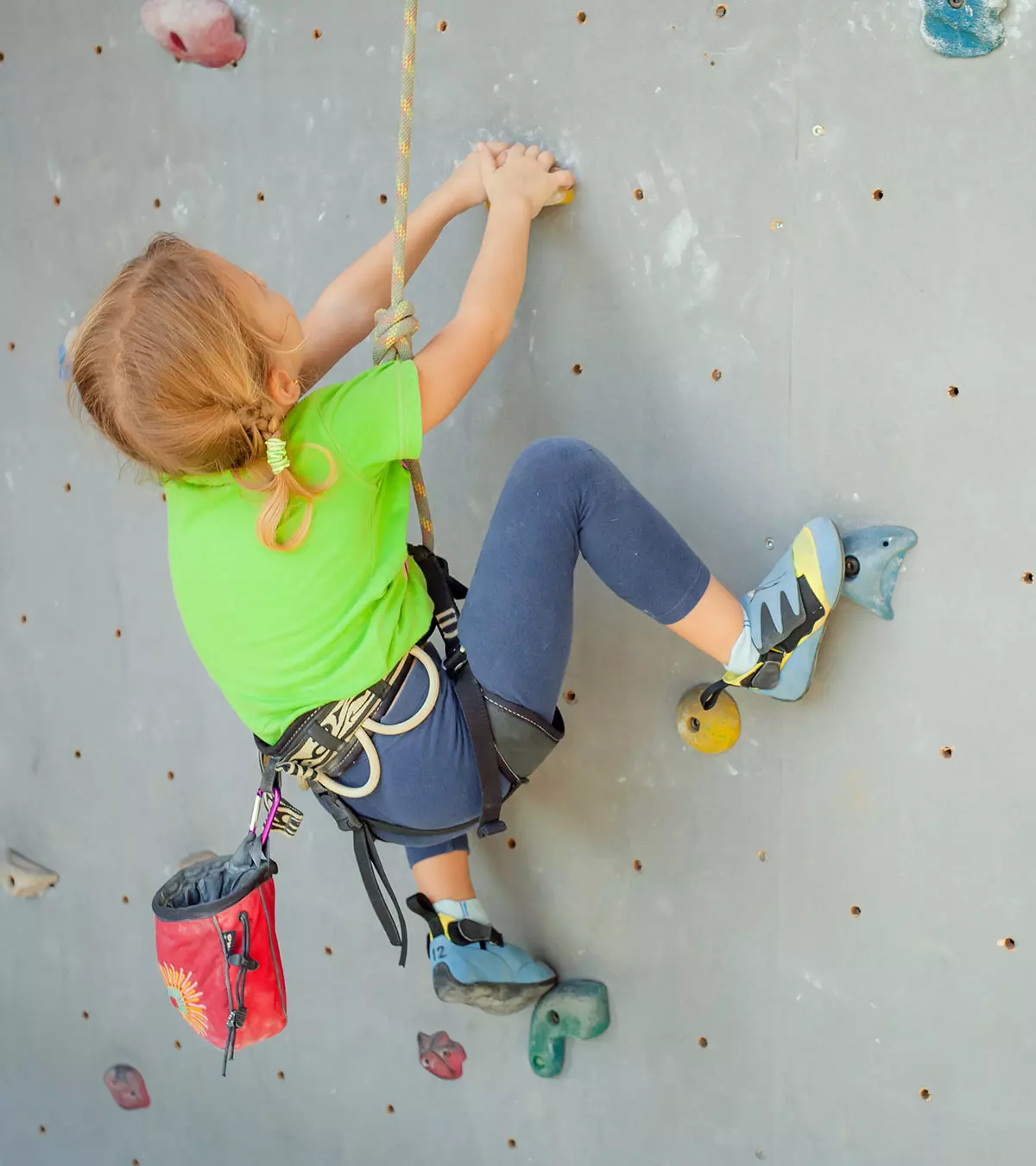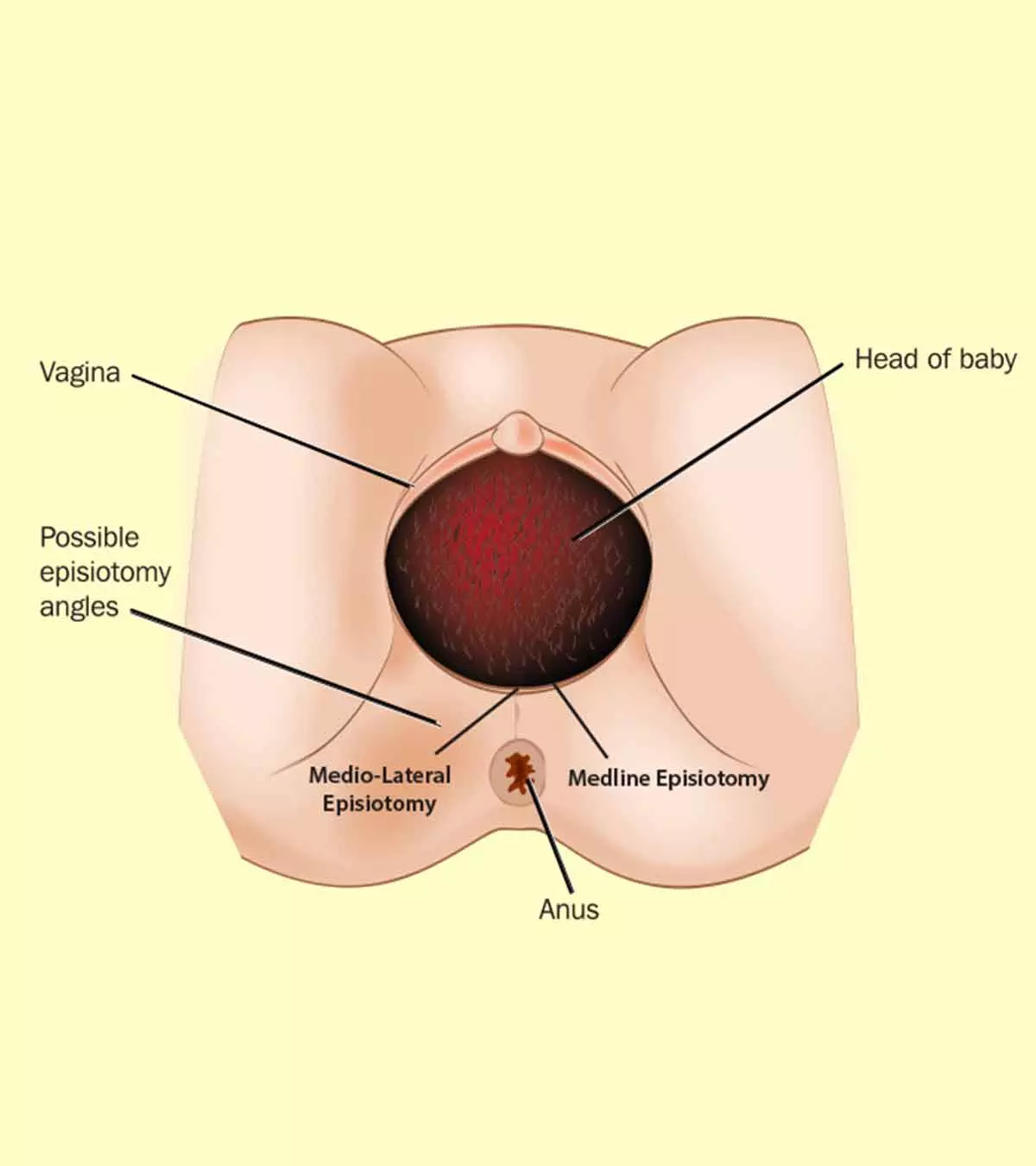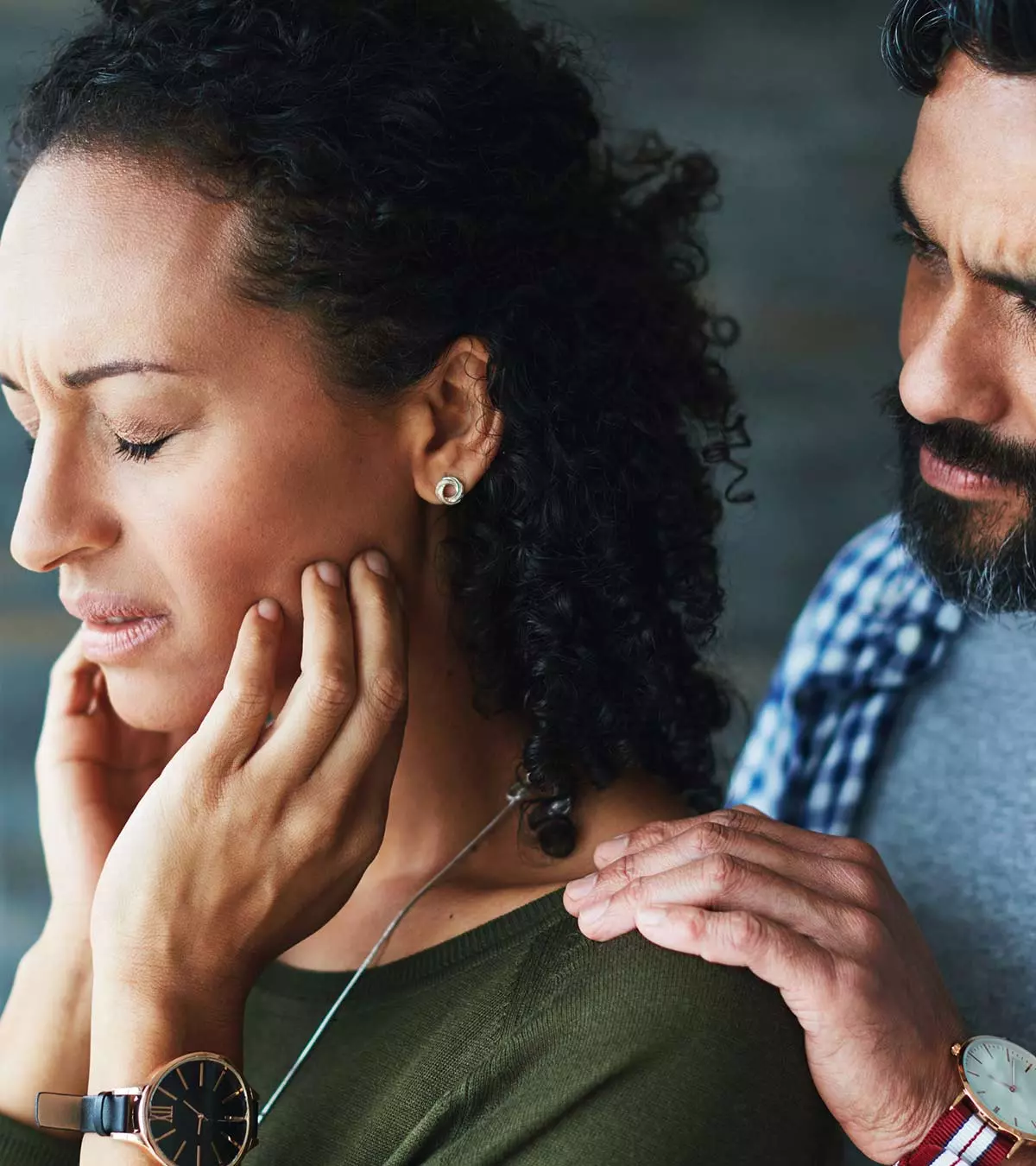

Image: Shutterstock
At a time when parents are concerned about sedentary lifestyles, rock climbing for kids could be a useful fitness activity for them. Climbing a rock (hill or mountain) with only your hands, legs, and a safety rope connected through a body harness is called rock climbing. Even in 200 BC, the practice was fashionable in China, and it has long been a popular pastime in Europe.
In this post, let’s dig into different types of rock climbing, their benefits, and safety advice before introducing your children to the sport.
What Are The Types Of Rock Climbing?
Kids’ rock climbing can be an indoor or an outdoor activity. There are various types involved in both the activities. Some of them are:
1. Indoor Rock Climbing:
It is usually done on artificially built rock structures and allows you to climb in all weather conditions and at any time of the day. Indoors are used as a means to improve one’s climbing skills and techniques, and also for exercise and fun. It offers rope setups and safe techniques.
Getting Trained For Indoor Rock Climbing Wall For Kids:
Indoor rock climbing for kids is an extremely challenging experience. An easy way to begin the activity for him is to practice climbing a wall. Let your kid practice on a wall with a simple surface and then move on to more complex surfaces.
- The climbing wall can be of different heights and have varying levels of difficulty.
- Your kid can practice on the climbing wall in school, at a local kids’ sports club, or at a nearby gym that also offers to coach your kids. If you have space, you can set up a climbing wall at home.
- The climbing wall will contain polyurethane climbing holds that your kids can grasp while climbing.
- You may also find a climbing wall with a flat surface.
- Other kinds of climbing walls may have textures that replicate hilly or mountainous terrain and give your kid an almost real rock climbing experience.
- Your kid should be mindful of where other people are climbing. It is important that he does not climb right underneath someone as it can trigger an accident.
- As your kid heads towards the rock climbing wall, tell him to walk and not run.
- Educate your kid about the importance of taking turns and letting others move or finish. He should be patient and wait for other climbers to reach a safe distance before beginning to climb or move further.
- Test the safety gear before your kid wears it while climbing the wall.
2. Outdoor Rock Climbing:
It is done on sunny days where the supports provide good grip as they get dry.
3. Traditional or Trad Climbing:
In this style of rock climbing, the climber places the protection gear on his way to climbing the rock and the partner (the second climber) removes it while passing the route. This climbing requires great technical knowledge and experience.
Controlling the rope is termed as belay, and the person controlling it is called a belayer.
4. Sport Climbing:
It is a kind of trad climbing, but has fixed protection, which climbers use while they are ascending. This is more accessible to learners as it does not require as much gear as traditional climbing does.
5. Top-Rope Climbing:
The climber uses an anchor for safety. One end of the rope is tied to the climber and the other end is with the belayer. In between it passes through the support gear. The belayer pulls the rope when the climber is ascending, to hold him in place. It is usually used by advanced climbers as it helps to focus on endurance and strength building.
6. Competition Climbing:
This is done on artificial climbing walls and supports. They are used to test the climber’s ability and are widely used in competitions.
7. Lead Climbing:
In this style of rock climbing, the leader ascends by attaching himself to a rope while the belayer holds the rope underneath. The climber reaches the one pitch and then attaches a support, then he belays the second. If the climber falls, the belayer will arrest his fall.
8. Bouldering:
It is a style of climbing where the climber will not use any rope or harness because the walls are usually below 25 feet. They are practiced on small rocks and at indoor walls. The routes are difficult, and there is a possibility to jump back on the ground. Therefore, crash pads are used to reduce the impact of landing on the ground.
9. Solo Climbing:
Solo climbing or soloing is a style of climbing where the climber ascends alone without any protection or belayer. One type of solo climbing is roped soloing, where a rope is used as a support. Another new form is deep water soloing where the climber ascends over the water body, which acts as a protection in case of a fall.
10. Aid Climbing:
In this style of rock climbing, certain devices are fixed for protection to ascend safely. It is practiced on big walls where free climbing is difficult. It emphasizes on physical and mental endurance rather than brute strength and power.
11. Scrambling:
Scrambling is an ambiguous term which involves hiking, mountaineering, hillwalking and rock climbing. It is walking into the steep terrain with the use of hands. If the rock is highly steep, you will find hard to scramble and require more equipment or skills.
Indoor vs. Outdoor Rock Climbing
If you are in confusion to choose between indoor and outdoor rock climbing for children, we try to resolve it here:
- Indoor climbing is done in an environmentally controlled area and climbing the walls is safer than climbing real mountains. This style of climbing is best for those who require constant practice before they go big.
- In indoor climbing, surfaces are visible and can be distinguished from the wall whereas in natural walls, they cannot be seen from the top.
- Focusing is much easier in indoor climbing as distractions are significantly lower than in outdoor climbing. Outdoor rock climbing will have erratic wind conditions and insects that may hamper the climb.
- Indoor climbing will have different levels to try and excel. You can choose a suitable one for your kid. Outdoor rock climbing paths are diversified since holds are not fixed. Every crack and slope will serve as a hold.
- Outdoor climbers can experience fresh breeze and sun, and they get a view of the beautiful surroundings.
- Outdoor climbing is more challenging as the climbers have to figure out the route without the use of any guides. Indoor climbing has colored markers to make climbing easier
What Are The Benefits Of Rock Climbing For Kids?
- Rock climbing is a complete workout for your kid.
- It improves your kid’s muscular endurance and flexibility, his overall balance and coordination skills.
- As your kid moves from one phase of rock climbing to the next, it will enhance his confidence.
- Being in a rock climbing club or group will let your kid interact with other kids or grownups with similar interests. Your kid will learn to socialize and work in groups.
- Rock climbing will also teach your kid the importance of practicing safety measures and taking instructions as he would have to listen to and follow the instructor.
- Practicing rock climbing will improve your kid’s concentration, focus, and learning abilities. It will also do good to your child’s sensory and fine motor skills.
Rock Climbing Safety Tips For Kids
- Your kid’s safety should be of primary concern when you encourage him to climb rocks.
- Make sure your kid understands instructions carefully before he starts climbing. It will help him be safe and not cause any injury to himself or others.
- Place a padded mat at the bottom of the climbing wall in case of an accidental slip or fall.
- Wearing proper safety gear, such as a rock climbing helmet, and shoes is inevitable. He needs to be harnessed to a strong rope.thrice
- The rock climbing harness will protect your kid from slipping or falling. The harness should be neither too loose nor too tight.
- A good option could be to get a belaying device and attaching it to the harness to help your kid while he is rappelling.
- Make sure your kid does not attempt to climb without proper supervision, even if he has had enough practice. An adult, who is well-versed with rock climbing, should be present at all times.
Rock Climbing Techniques For Kids
1. Warm Up And Stretch:
Stretching increases blood circulation and offers flexibility, improving climbing. Through simple stretch and warm up exercises your child can prevent injuries. They provide mobility in the ligaments, joints, and muscles.
2. Strength Of Grip:
The simple trick to a right grip is to relax. Over-gripping is not good as it wears out the forearms. Let your kid practice forearm exercises as it helps improve the grip. The strength results in better fluid movement and improves balance, endurance, and performance when climbing.
3. Improve Balance:
Your child’s ability to balance is a basic requirement for developing climbing techniques. The feet may be close, spread, or in stance, but the center of balance is focused on the body mass.
You should teach your kid the sense of balancing so that he can move smoothly and effortlessly. A simple exercise that helps improve the center of gravity is to climb a wall that is at least 60 degrees slant and lets your kid climb using his feet alone. Let him traverse back and forth. It will help in improving his balance, offering muscle memory.
4. Keep The Body Close To Wall:
Climbers should also keep their center of gravity balanced in a forward-backward direction. To be more accurate with the balance, one needs to be closer to the wall. Let your kid experiment with different distances and stances so that he can adapt to various conditions.
5. Speed Of Climbing:
Some kids may be slow as they adopt a static technique. Some may opt the dynamic technique where they are fast. Static moves require small hand and foot holds. Here, legs are used to support weight and arms to hold the body in place. Dynamic climbing moves need extra upper body grip and forearm strength.
6. Smooth Movement:
Ask your kid to be conscious of the movements so that he can climb smoothly. If he is not conscious, he may end up falling or slipping. Tell him to be still and relaxed.
7. Taking A Good Fall:
No matter how good a climber your kid may be, he could still fall. In addition to skills, your child needs to develop mental control too..Prepare him for the falls, and teach him how to recover from them.
8. Watching And Learning:
The best way to improve rock climbing is to help you kid watch good climbers and practice with them. After all, practice makes a man perfect.
Great Rock Climbing Places For Your Kids
Here are some great places you can take your kids for climbing. They will surely get a solid dose of fun and memories that remain for the lifetime.
1. Rockreation Sport Climbing Center:
The 12,000sq.feet sculpted terrain offers a great climbing experience to your little ones.
Location:
1300 Logan Ave.
Costa Mesa, CA 92626
(714) 556 7625
2. Rock City Climbing:
It offers free climbing 101 and belay training that includes harness, free class, shoes and a three-week unlimited membership.
Location:
5100 E. La Palma Ave. 108
Anaheim, CA 92807
(714)777 4884
3. Arcadia Rock Climbing:
It is one of the largest indoor rock climbings in the US and offers great bouldering programs for learners.
Location:
305 N. Santa Anita Avenue
Arcadia, CA 91006
(626) 294-9111
4. Hangar 18:
It has a 55,000sq.feet textured climbing terrain, caves and world-class bouldering for kids.
Location:
256 E Stowell St
Upland, CA 91786
(909) 931-5991
5. The Factory Bouldering:
The indoor climbing terrain in Southern California has a bouldering area.
Location:
1547 West Struck Ave Ste A
Orange, CA 92867
(714) 639 7625
6. The Circuit:
It offers a safe area to climb without ropes. Has soft floor padding and colorful routes for kids to puzzle out.
Location:
6050 Southwest Macadam
Avenue Portland
503-246-5111
7. Portland Rock Gym:
Opened 20 years ago, it offers a thrilling experience to kids.
Location:
21 NE 12th Avenue
Portland
503-232-8310
8. Stoneworks Climbing Gym:
It offers a variety of summer camps and belay packages for kids.
Location:
6775 SW 111th Avenue
Beaverton
503-644-3517
Rock Climbing Terms To Know
Here are some rock climbing terms, which you and your kid can get acquainted with while getting involved in the activity:
Rappelling:
Also called abseiling, it is the controlled sliding down from a rock using ropes. The primary goal is to climb down a steep slope or cliff. The person controls the descent rate with the help of friction created by a device connected to the rope. The equipment used in the activity includes a harness, carabiner, locking, and belay device.
Belaying:
It is a technique of holding the climbing rope so that the climber is safe and does not fall. A belayer helps to pass the rope using a belay device, which will force the rope through a series of turns, thus increasing the friction.
Ascender:
It is a device for climbing the rope when every other support fails. It can be a simple friction knot or a sophisticated device.
Crack:
A fissure or split in the rock. Wide cracks are called chimneys or off-widths, and horizontal cracks are called breaks. A thin crack is also known as a seam.
Flake:
A partially separated part of rock, which provides a hold along with the detached edge.
Overhang:
A surface of the rock where the top extends beyond the bottom and allows the gravity to come into play.
Rock climbing for kids helps strengthen their muscles besides being a fun indoor and outdoor sports activity. With several types of climbing activities available, such as top-rope climbing, trad climbing, and aid climbing, choose the one most apt for your child based on their skills and interests. While indoor climbing is done in a controlled environment, outdoor climbing might be challenging. Overall, it would be helpful to note the different types, benefits, and safety measures of rock climbing before you indulge your children in this sport.
Community Experiences
Join the conversation and become a part of our nurturing community! Share your stories, experiences, and insights to connect with fellow parents.
Read full bio of Dr. Maymunah Yusuf Kadiri
Read full bio of sanjana lagudu
















